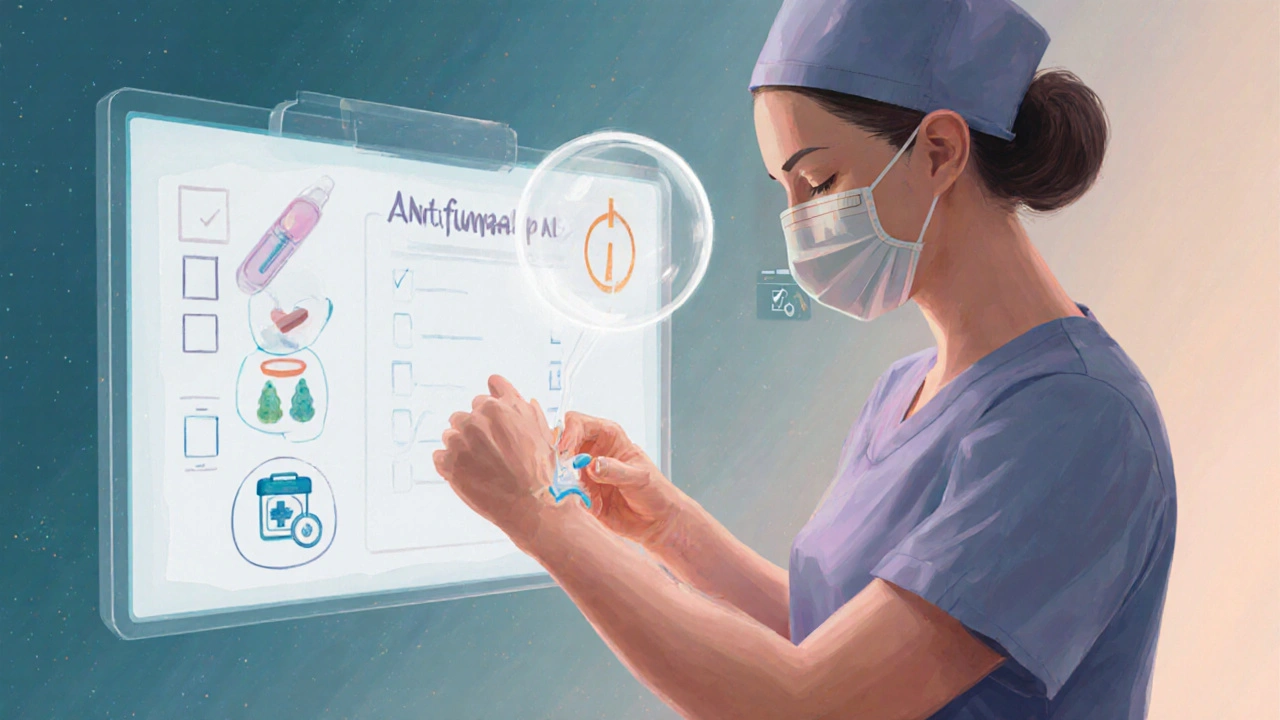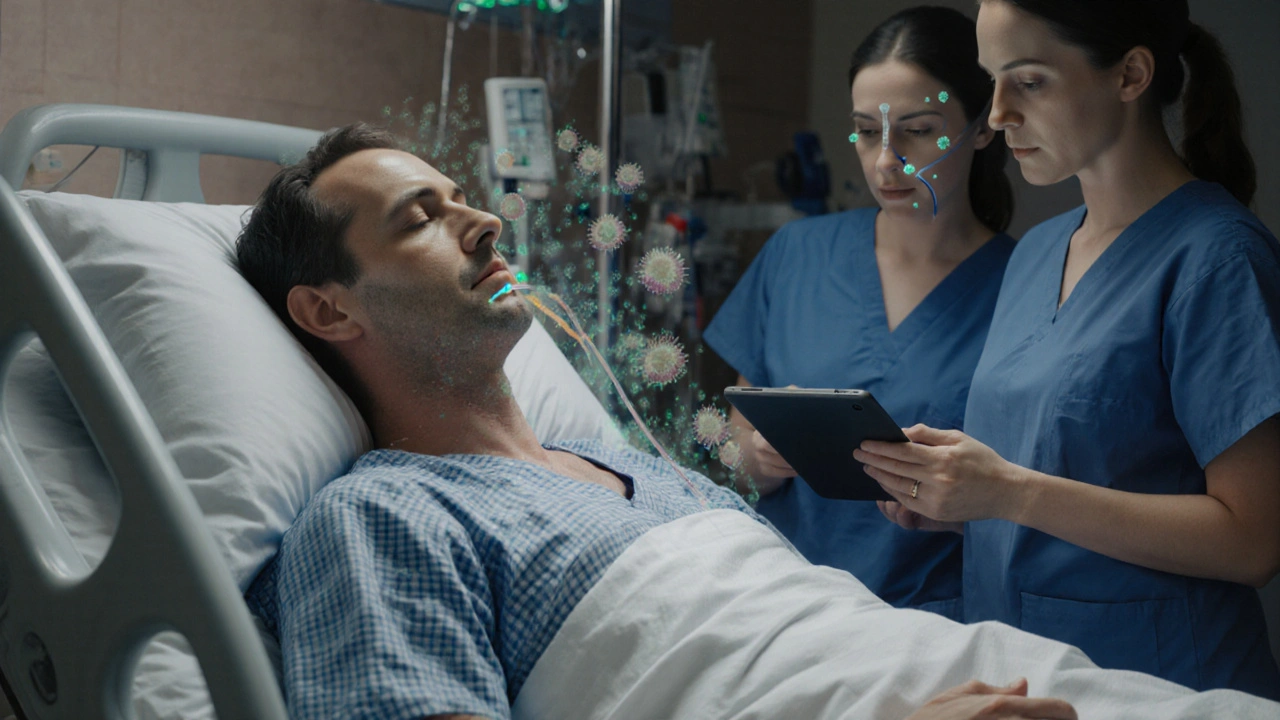Quick Take
- Catheters, especially central venous catheters, are the #1 source of candidemia in ICU patients.
- Candida forms biofilms on catheter surfaces, shielding it from antifungal drugs.
- Early diagnosis hinges on paired blood‑culture and catheter‑tip culture.
- Guidelines recommend prompt catheter removal plus echinocandin therapy for most cases.
- Prevention focuses on insertion bundles, antiseptic skin prep, and antimicrobial lock solutions.
Catheter is a medical device inserted into a vessel or body cavity to deliver fluids, medications, or to obtain specimens. In modern hospitals, the most common types are central venous catheters (CVCs) and peripheral intravenous catheters (PIVCs).
Candidemia refers to the presence of Candida yeasts in the bloodstream. It is a subset of disseminated Candida infection, where the fungi seed multiple organs and can lead to end‑organ damage.
Candida species include C. albicans, C. glabrata, C. tropicalis, C. parapsilosis, and C. auris. Each species differs in virulence, drug susceptibility, and propensity to form biofilm on artificial surfaces.
Biofilm is a structured community of microorganisms embedded in an extracellular matrix that adheres to a surface, such as a catheter lumen.
Antifungal therapy encompasses drugs like echinocandins, fluconazole, and amphotericin B, chosen based on species, susceptibility, and patient condition.
Catheter‑related bloodstream infection (CRBSI) is defined by the isolation of the same pathogen from a peripheral blood culture and the catheter tip, after excluding another source.
IDSA guidelines provide evidence‑based recommendations for the management of candidemia, emphasizing early catheter removal and echinocandin initiation.
Understanding Candidemia and Disseminated Candida Infections
Candidemia is the most common invasive fungal infection in critically ill patients, accounting for 10-15% of all bloodstream infections in intensive care units. When Candida spreads beyond the bloodstream, it can involve the kidneys, eyes, brain, and heart, a condition termed disseminated Candida infection. Mortality rates hover around 40% for candidemia alone, climbing above 60% when dissemination occurs.
Risk factors are well documented: prolonged ICU stay, broad‑spectrum antibiotics, total parenteral nutrition, neutropenia, and, most notably, the presence of an intravascular catheter. Among these, catheters provide a direct conduit for yeast to enter the bloodstream and a surface for colonisation.
Why Catheters Are a Perfect Launch Pad for Candida
Catheters breach the body’s natural barrier. Once placed, the lumen is coated with host proteins-fibrinogen, fibronectin, and collagen-creating a “conditioning film” that Candida readily adheres to. Within hours, yeast cells attach, proliferate, and secrete extracellular polymeric substances, establishing a biofilm. This matrix can be up to 100µm thick, dramatically reducing drug penetration and protecting the community from the immune system.
Central venous catheters are especially problematic because they sit in large veins, expose larger surface area, and often remain in place for weeks. Studies from Australian tertiary hospitals show that CVC‑related candidemia rates average 1.2 episodes per 1,000 catheter‑days, compared with 0.3 per 1,000 for peripheral lines.
Species‑specific traits matter. C. parapsilosis, for example, is notorious for thriving on plastic surfaces, while C. auris-an emerging multidrug‑resistant pathogen-forms robust biofilms that survive standard disinfection protocols.
Diagnosing Catheter‑Related Candidemia
Timely diagnosis hinges on a combination of laboratory and clinical clues. The classic algorithm is:
- Obtain at least two sets of peripheral blood cultures drawn from separate sites.
- Simultaneously draw a culture from the catheter lumen (draw‑through method) or culture the catheter tip after removal.
- Run a differential time‑to‑positivity (DTP) analysis; a DTP of >2hours favoring the catheter culture strongly suggests CRBSI.
- Consider molecular tools-real‑time PCR or MALDI‑TOF-when cultures are negative but suspicion remains high.
Blood culture sensitivity for Candida hovers around 50%, improving to 70% when enriched bottles are used. Therefore, clinicians often start empirical therapy before definitive results, especially in septic patients.

Managing Infections: Removal vs. Retention
The IDSA guidelines make a clear recommendation: remove the implicated catheter as soon as candidemia is confirmed, unless removal is technically impossible or the patient is unstable. Studies show that delayed removal (>48h) increases mortality by 12%.
When removal is not feasible, an antifungal lock solution-typically an echinocandin mixed with heparin-can be instilled into the lumen for 12-24hours daily. This approach has shown success rates >70% in retrospective cohorts, though data remain limited.
Therapeutic choice:
- Echinocandins (caspofungin, micafungin, anidulafungin) are first‑line because of their activity against biofilm‑embedded cells and low toxicity.
- Fluconazole may be stepped down to once susceptibilities are confirmed and the patient is stable.
- Amphotericin B is reserved for resistant strains or when rapid fungicidal activity is required.
Therapy duration is usually 14days after the first negative blood culture, provided the catheter has been removed and there is no evidence of metastatic infection.
Prevention Strategies: Keeping Catheters Clean
Prevention is a multi‑layered effort:
- Insertion bundles: strict hand hygiene, maximal sterile barrier precautions, chlorhexidine‑based skin antisepsis, and real‑time ultrasound guidance.
- Daily review: assess catheter necessity each shift; remove as soon as it is no longer essential.
- Antimicrobial catheter materials: impregnated with chlorhexidine‑silver or minocycline‑rifampin have shown a 30-50% reduction in CRBSI rates.
- Antiseptic lock solutions: 2% citrate or ethanol locks can suppress colonisation, especially in long‑term central lines.
- Environmental controls: dedicated line insertion carts, regular staff education, and audit‑feedback loops.
In a 2023 multicenter trial in Melbourne, a bundle that combined chlorhexidine skin prep and antimicrobial‑impregnated catheters cut CVC‑related candidemia from 1.2 to 0.4 per 1,000 catheter‑days.
Comparison: Central Venous vs. Peripheral Catheters
| Attribute | Central Venous Catheter (CVC) | Peripheral IV Catheter (PIVC) |
|---|---|---|
| Typical dwell time | 5-30days | 1-4days |
| Major infection risk (per 1,000 catheter‑days) | 1.2episodes of candidemia | 0.3episodes of candidemia |
| Biofilm formation propensity | High (plastic & silicone surfaces) | Moderate (smaller lumen, less surface area) |
| Recommended insertion site prep | 2% chlorhexidine in 70% alcohol | 70% alcohol or povidone‑iodine |
| Standard removal trigger | Any sign of CRBSI, catheter‑related thrombosis, or no longer needed | Loss of patency or completion of therapy |
Looking Ahead: Emerging Technologies and Research
Two front‑line innovations are reshaping how we tackle catheter‑related candidemia:
- Nanostructured antimicrobial coatings: copper‑silver nanocomposites have demonstrated >99% reduction in Candida biofilm formation in vitro and are moving into clinical trials.
- Rapid point‑of‑care diagnostics: electrochemical biosensors that detect Candida DNA from catheter lumens within 30minutes could shave hours off the time‑to‑therapy.
Both promise to lower the incidence of CRBSI and to guide targeted therapy earlier, potentially improving survival by up to 8% in high‑risk populations.

Frequently Asked Questions
What makes catheters such a common source of candidemia?
Catheters breach the skin, providing a direct entry point for Candida. The device surface quickly becomes coated with host proteins, which the yeast uses to attach and form a protective biofilm. This shields the organisms from both the immune system and antifungal drugs, allowing them to multiply and enter the bloodstream.
Should every catheter be removed once candidemia is diagnosed?
Current IDSA guidelines advise prompt removal of the implicated catheter unless removal would cause immediate harm or is technically impossible. Early removal improves survival and reduces the risk of metastatic infection.
How effective are antimicrobial lock solutions for Candida?
Lock solutions using echinocandins or high‑concentration ethanol can eradicate Candida biofilm in up to 70% of cases when the catheter cannot be removed. They are considered adjunctive therapy and should be combined with systemic antifungals.
Which Candida species are most likely to cause catheter‑related infections?
C. albicans remains the leading cause, but C. parapsilosis and C. glabrata are increasingly seen, especially in ICU settings. Emerging multidrug‑resistant C. auris has a strong propensity for biofilm formation and can persist despite standard disinfection.
What preventative measures have the biggest impact?
A bundled approach-strict hand hygiene, maximal sterile barrier protection during insertion, chlorhexidine‑based skin antisepsis, daily catheter‑necessity assessment, and use of antimicrobial‑impregnated catheters-can cut CVC‑related candidemia rates by more than 60%.


Brian Lancaster-Mayzure
September 27, 2025 AT 21:01Hey folks, just wanted to add that early removal of any suspect catheter, combined with an echinocandin, really cuts down mortality – it’s a simple step that many units still overlook, so keeping an eye on daily line necessity can make a huge difference.
Erynn Rhode
September 28, 2025 AT 10:55In reviewing the literature, one cannot help but notice the elegance with which the authors have delineated the cascade from catheter insertion to candidemia; the systematic presentation of biofilm dynamics, coupled with the nuanced discussion of antifungal lock therapies, provides a most comprehensive overview, and while the data are robust, the occasional typographical oversight does little to diminish the overall scholarly merit 😊; moreover, the emphasis on chlorhexidine‑based skin preparation as a cornerstone of prevention aligns perfectly with established infection control protocols, thereby reinforcing the importance of adherence to evidence‑based bundles.
Rhys Black
September 29, 2025 AT 00:48It is frankly disheartening to observe how, despite the avalanche of empirical evidence, some institutions continue to flout the basic tenets of sterile technique; such negligence is not merely a lapse in protocol but an affront to the very ethic of patient safety, and it behooves every clinician to internalize the moral imperative of removing potentially infected lines without delay.
Abhishek A Mishra
September 29, 2025 AT 14:41When we look at cathetr‑related candidemia, the real issue often lies in the prolonged dwell time; even a short period of unnecessary use can give Candida the foothold it needs to establish a stubborn biofilm, so regular review of line necessity is key.
Jaylynn Bachant
September 30, 2025 AT 04:35One might ponder whether the catheter, a mere conduit of life‑saving fluids, becomes a paradoxical vessel of death when colonized by invisible fungi, reminding us that every technological marvel carries within it the seed of its own potential downfall.
Anuj Ariyo
September 30, 2025 AT 18:28Catheters, when placed, create a direct path, a protected niche, a surface for microbes, and if not removed promptly, they become a breeding ground, leading to serious bloodstream infections, especially in vulnerable patients.
Tom Lane
October 1, 2025 AT 08:21Absolutely, Brian! Keeping the team informed about line reviews and making removal decisions together really builds a culture of safety, and the early switch to echinocandins can save lives – great point.
Darlene Young
October 1, 2025 AT 22:15The data you highlighted about antimicrobial‑impregnated catheters are spot‑on; hospitals should fast‑track adoption of these devices, as they demonstrably slash infection rates, and staff education on lock solutions must be relentless to maintain those gains.
Steve Kazandjian
October 2, 2025 AT 12:08Remove the line ASAP.
Roger Münger
October 3, 2025 AT 02:01Current guidelines unequivocally state that catheter removal should occur as soon as candidemia is documented, because the catheter often serves as the primary nidus for persistent infection. Evidence from multicenter trials indicates that delays beyond 48 hours markedly increase mortality, underscoring the urgency of this intervention. Moreover, the pharmacokinetics of echinocandins demonstrate superior activity against biofilm‑embedded Candida compared with azoles, rendering them the agents of choice in most scenarios. Species identification remains critical, as C. glabrata and C. auris may exhibit reduced susceptibility to fluconazole, necessitating empirical echinocandin therapy. Blood culture sensitivity for Candida, while historically limited to around 50 percent, can be enhanced by employing pediatric‑bottle enrichment techniques. Differential time‑to‑positivity provides a valuable adjunct, with a greater than two‑hour advantage for catheter draws strongly suggesting line‑related infection. Molecular diagnostics, including PCR and MALDI‑TOF, are increasingly accessible and can reduce time to definitive identification. Antifungal lock therapy, particularly with high‑dose echinocandins, offers a viable salvage strategy when line retention is unavoidable. Nonetheless, lock solutions should be viewed as adjunctive, never replacing systemic therapy. Chlorhexidine‑based skin antisepsis before insertion has been shown to reduce colonization rates and should be standard practice. Daily assessment of line necessity, coupled with prompt removal of superfluous catheters, forms the cornerstone of infection prevention bundles. The economic burden of catheter‑related candidemia is substantial, encompassing prolonged ICU stays and costly antifungal regimens. Thus, investing in preventive measures yields both clinical and financial dividends. Education of nursing staff on aseptic techniques remains a pivotal element in sustaining low infection rates. Finally, ongoing surveillance and feedback loops enable institutions to track performance and adjust protocols dynamically.
Gerald Bangero
October 3, 2025 AT 15:55Indeed, the paradox you described reminds us that vigilance and humility are our best allies; by respecting the delicate balance between intervention and intrusion, we can harness technology without succumbing to its hidden threats.
John Nix
October 4, 2025 AT 05:48It is imperative, therefore, that institutional policies mandate routine catheter audits, ensuring that each device’s continued presence is justified by a clear clinical indication, thereby aligning practice with the highest standards of patient care.
Mike Rylance
October 4, 2025 AT 19:41Thank you for emphasizing collaborative line‑review processes; implementing structured multidisciplinary check‑lists will undoubtedly reinforce adherence to best practices and accelerate timely catheter removal.
Becky B
October 5, 2025 AT 09:35While your advocacy for antimicrobial catheters is commendable, one must also consider the hidden agendas behind pharmaceutical push‑backs; the truth is that many of these “innovations” are designed to profit from fear, and we should remain skeptical of uncritical adoption.
Aman Vaid
October 5, 2025 AT 23:28Although the directive to “remove the line ASAP” captures urgency, a more nuanced approach involves confirming bloodstream infection via differential time‑to‑positivity, documenting catheter tip cultures, and then orchestrating removal in concert with antifungal initiation to minimize downstream complications.
xie teresa
October 6, 2025 AT 13:21I appreciate the thorough overview you provided; such detailed guidance is invaluable for clinicians navigating the complexities of catheter‑related candidemia, and your emphasis on both prevention and timely intervention offers a clear roadmap for improving patient outcomes.